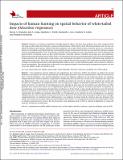Impacts of human hunting on spatial behavior of white-tailed deer (Odocoileus virginianus)
Abstract
Predators can influence populations through top-down effects, but most large predators have been extirpated from the white-tailed deer’s (Odocoileus virginianus) range. Hunters have filled this predatory role, but also can indirectly influence prey species. Indirect behavioral responses can include altered resource selection, space use, or movement patterns. Herein, we developed a controlled study that contained both temporal and spatial risk levels to assess how deer behavior changes in space relative to temporal periods of risk. Total distance travelled (m) and micro-range area (m²) were calculated over two-day periods to determine the general effects of hunting season on deer spatial behavior. Generally, distance travelled, micro-range area, and exploratory behavior decreased during the course of the study, with the greatest decrease occurring during the active 16-day hunting period. Despite potential risk and disturbance from hunters, deer maintained site fidelity to previously established ranges and did not expand micro-range areas. These data indicate that deer recognize threats from humans on the landscape and adapt behavioral strategies by minimizing movement and exhibiting high residency times in well-established ranges, factors known to influence harvest susceptibility. This information can be used to assess potential impacts from hunting for management purposes, but also to test the adaptive ability of animals to risk.
Citation
Marantz , S A , Long , J A , Webb , S L , Gee , K L , Little , A R & Demarais , S 2016 , ' Impacts of human hunting on spatial behavior of white-tailed deer ( Odocoileus virginianus ) ' , Canadian Journal of Zoology , vol. 94 , no. 12 , pp. 853-861 . https://doi.org/10.1139/cjz-2016-0125
Publication
Canadian Journal of Zoology
Status
Peer reviewed
ISSN
0008-4301Type
Journal article
Description
This study was funded by The Samuel Roberts Noble Foundation, Inc., and the Department of Wildlife, Fisheries and Aquaculture at Mississippi State University.Collections
Items in the St Andrews Research Repository are protected by copyright, with all rights reserved, unless otherwise indicated.

